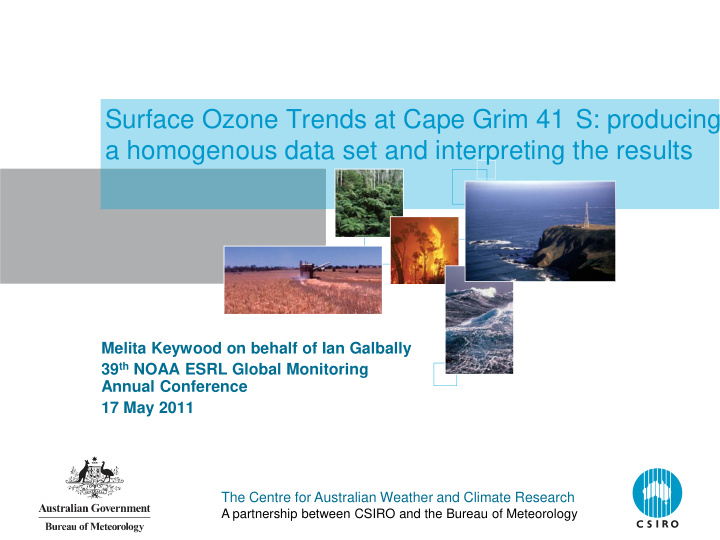



Surface Ozone Trends at Cape Grim 41 S: producing a homogenous data set and interpreting the results Melita Keywood on behalf of Ian Galbally 39 th NOAA ESRL Global Monitoring Annual Conference 17 May 2011 The Centre for Australian Weather and Climate Research A partnership between CSIRO and the Bureau of Meteorology
Acknowledgements The Cape Grim program, established by the Australian Government to monitor and study global atmospheric composition, is a joint responsibility of the Bureau of Meteorology and the CSIRO Staff (past and present) involved on the ozone program include: CSIRO: Ian Galbally, Suzie Molloy Simon Bentley, Mick Meyer, Malcolm Elsworth, Wayne Knight, Michael Douglas, Ian Morrissey, John Osborne, Jason Ward Cape Grim: Laurie Porter, Ross Paterson, Randall Wheaton, Stuart Baly, Jeremy Ward Collaboration: Sam Oltmans NOAA The Centre for Australian Weather and Climate Research A partnership between CSIRO and the Bureau of Meteorology NOAA-ASM May 2011
The scientific challenge: can we observe, explain and predict: • the current distribution of ozone in the troposphere? • the past and future trends in ozone in the troposphere? Do we understand: • the distribution of ozone source and sink regions in the southern hemisphere troposphere? The Centre for Australian Weather and Climate Research A partnership between CSIRO and the Bureau of Meteorology NOAA-ASM May 2011
The Technical Challenge With changing and newly emerging technologies can/did we maintain an atmospheric ozone record over 30-50 years that: • is a representative record of ozone in the marine boundary layer upwind of Cape Grim • has internal consistency such that ozone variations on timescales from hours to decades are recorded with minimum and unchanging, or quantified, bias over the period of the record The Centre for Australian Weather and Climate Research A partnership between CSIRO and the Bureau of Meteorology NOAA-ASM May 2011
Cape Grim Ozone Equipment 1982 - 2010 • 3 Ozone monitors • 3 Inlets • Chart based, magnetic cassette and computer based analog and digital data acquisition • 3 sets of data reduction software • 3 Zero and Span units • 2 Calibrators • 3 International calibrations The Centre for Australian Weather and Climate Research A partnership between CSIRO and the Bureau of Meteorology NOAA-ASM May 2011
Cape Grim May 1978 The Centre for Australian Weather and Climate Research A partnership between CSIRO and the Bureau of Meteorology NOAA-ASM May 2011
Cape Grim Ozone System 2009 The Centre for Australian Weather and Climate Research A partnership between CSIRO and the Bureau of Meteorology NOAA-ASM May 2011
The Centre for Australian Weather and Climate Research A partnership between CSIRO and the Bureau of Meteorology NOAA-ASM May 2011
The long term trend The Centre for Australian Weather and Climate Research A partnership between CSIRO and the Bureau of Meteorology NOAA-ASM May 2011
Cape Grim Surface Ozone Yearly Trend Analysis based on monthly anomalies. Units: Intercept – ppb. Slope = β 1 - ppb/y. CI = 95% The Centre for Australian Weather and Climate Research A partnership between CSIRO and the Bureau of Meteorology
Cape Grim Surface Ozone Seasonal Trend Analysis based on monthly anomalies. • Surface ozone in Austral spring (SON) and summer (DJF) show positive trends in the 1980’s and 1990’s and non-significant trends in the 2000’s and positive trends over the three decades combined • Surface ozone in Austral autumn (MAM) and winter (JJA) show non-significant trends in each of the three decades. Over the three decades there are ambivalent results concerning an upward trend in these seasons. The Centre for Australian Weather and Climate Research A partnership between CSIRO and the Bureau of Meteorology
The Centre for Australian Weather and Climate Research A partnership between CSIRO and the Bureau of Meteorology
Cape Grim Surface Ozone monthly anomalies vs SOI (ENSO) and SAM. • Correlation with SOI (ENSO) (r) • DJF (Summer) = +0.246 (n = 83) • MAM (Autumn) = +0.371 (n = 83) • JJA (Winter) = +0.171 (n = 83) n.s. • SON (Spring) = +0.384 (n = 83) • More intense convection in the Australian region tropics is associated with positive ozone anomalies at Cape Grim • Correlation with SAM = not significant The Centre for Australian Weather and Climate Research A partnership between CSIRO and the Bureau of Meteorology
Possible explanations of southern hemisphere tropospheric ozone trends (1) • Increased NO x , VOC and CO emissions from biomass burning causing the surface ozone increase in the South Atlantic region from 1970’s to present • Increased NO x emissions from shipping causing the surface ozone increase in the Southern Hemisphere from 1970’s to present The Centre for Australian Weather and Climate Research A partnership between CSIRO and the Bureau of Meteorology NOAA-ASM May 2011
Possible explanations of southern hemisphere tropospheric ozone trends (2) • Stratospheric ozone depletion causing increased tropospheric uv causing downward surface ozone trend from 1980’s to present at the South Pole? • Unidentified circulation changes: - latitude of high pressure belt, - mid latitude vertical overturning, - changed strat-trop exchange? The Centre for Australian Weather and Climate Research A partnership between CSIRO and the Bureau of Meteorology NOAA-ASM May 2011
The Centre for Australian Weather and Climate Research A partnership between CSIRO and the Bureau of Meteorology The challenge now is to find a key in the ozone record that indicates what has caused the changed concentrations. Thank you www.cawcr.gov.au Thank you
Recommend
More recommend